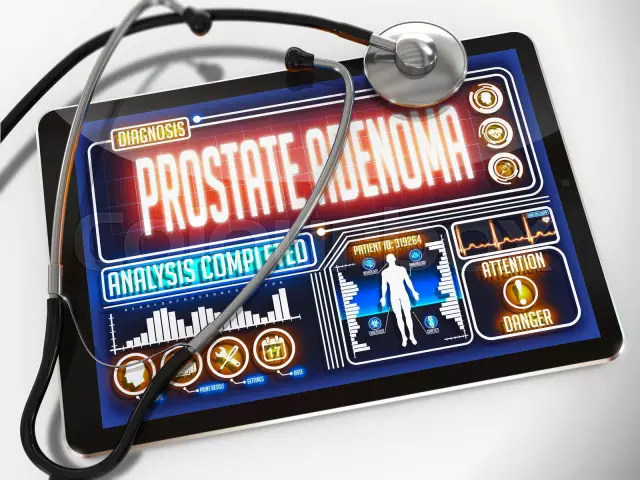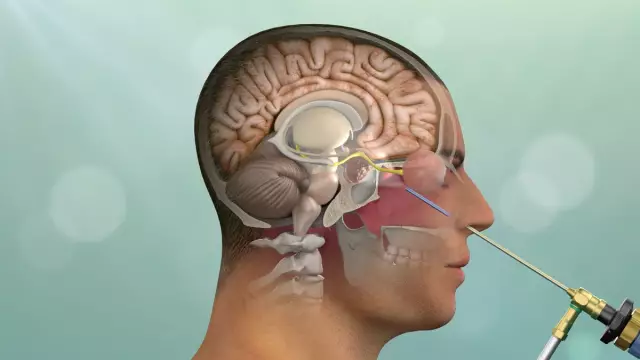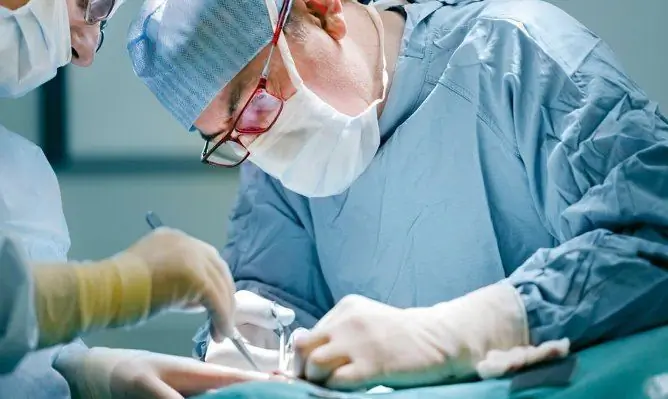- Author Rachel Wainwright [email protected].
- Public 2023-12-15 07:39.
- Last modified 2025-11-02 20:14.
BPH
General characteristics of the disease

Prostatic adenoma or prostatic hyperplasia is a common male disease. After about 40 years, age-related changes in the cellular structure occur in the human prostate gland. The cells grow and form into a benign tumor - prostate adenoma. This swelling gradually increases and begins to compress the urethra. This is how one of the main symptoms of prostate adenoma arises - the frequent urge to urinate.
Adenoma of the prostate of various forms of severity is diagnosed in half of men over 50 years old. In the age group of men 60-70 years, the incidence of the disease is already more than 70%.
A predisposing factor for the development of prostate adenoma is late male fertility. Thus, the earlier a man begins to involution of the genital glands, the less likely he is to develop prostate adenoma.
Among the causes of prostate adenoma in young men are hereditary predisposition to the disease, chronic inflammatory processes of the genital organs, as well as dietary habits.
The last factor needs more detailed study. However, at the moment it is already reliably known that the regular use of soy products, tomatoes, pumpkin, zucchini and green tea is an effective prevention of prostate adenoma. In regions where the above food products are included in the traditional menu, prostate adenoma is diagnosed much less often.
Symptoms of prostate adenoma
Only in 10-15% of men prostate adenoma is not subject to progressive growth. In most patients, unfortunately, the gradual proliferation of prostate tissue leads to the appearance of the first symptoms of prostate adenoma - disorders in the urinary system.
The early symptoms of BPH are, firstly, caused by compression of the bladder and urethra. Hence the frequent urge to urinate in a man with prostate adenoma.
And, secondly, hyperplasia of the tissues of the prostate gland always leads to increased activity of organ receptors. This causes a spasm of the muscles of the urethra and urinary disorders. Therefore, feeling the urge to urinate, a patient with prostate adenoma is not able to do what he wants.
In total, the symptoms of prostate adenoma include:
- weak or intermittent flow of urine during urination,
- a constant feeling of not completely emptying the bladder,
- increased urge to urinate, especially at night
- tension when urinating.
Pain and uncontrollable urge to urinate are considered more advanced symptoms of BPH.
Diagnostics of the prostate adenoma
Symptoms of prostate adenoma are similar to the clinical picture of prostate cancer - an extremely dangerous disease. Therefore, it is so important to carry out a thorough differential diagnosis of the disease in the early complaints of a patient about problems with urination.
A mandatory stage in the diagnosis of prostate adenoma is a physical examination: external to check the degree of swelling of the filled bladder above the bosom and digital rectal examination to study the condition of the seminal vesicles and the prostate gland.
More objective information about the stage of prostate adenoma can be obtained by transrectal or transabdominal ultrasound of the bladder and prostate gland. To assess the degree of urination disorder, another diagnostic method is used - uroflowmetry.
In the differential diagnosis of prostate adenoma, laboratory blood tests are also used for the presence of prostate-specific antigens and serum creatinine in it.
Treatment of prostate adenoma

The tactics of treating prostate adenoma depends on the age of the patient, his general state of health, as well as the degree of hyperplasia of the prostate tissue.
In the drug treatment of prostate adenoma, drugs of 2 different mechanisms of action are used:
- adrenergic blockers to block hypersensitivity of bladder receptors, improve blood supply to the walls of the organ and better contractility of the urethra.
- 5-a-reductase inhibitors to prevent further proliferation of prostate tissue.
In the conservative treatment of prostate adenoma, herbal preparations with anti-edematous and anti-inflammatory effects are also often used, for example, drugs based on the extract of the fruit of the Serenoa repens palm tree, burdock seed and roots, etc.
Unfortunately, medical treatment of prostate adenoma is often only able to improve the patient's quality of life. In addition, in order to consolidate the effect of conservative treatment of prostate adenoma, the patient needs frequent repetition of courses of drug therapy.
A radical method of treating prostate adenoma is an operation to remove tissue from the hyperplastic prostate gland.
Among several types of surgery to remove prostate adenoma, there are methods of open and closed resection. Open surgery to remove prostate adenoma is performed in the transvesical or retropubic area.
Closed surgery to remove prostate adenoma is performed endoscopically. The minimally invasive methods of treating prostate adenoma include:
- microwave thermotherapy,
- laser ablation,
- electric frequency impact
- and electrovaporization of prostate tissue.
The rehabilitation period after surgery for prostate adenoma
After surgery for prostate adenoma, the patient needs special conditions for recovery for some time. The rehabilitation period is on average 3 weeks.
After surgery for prostate adenoma, it is extremely important for the patient to follow a diet: to exclude pickles, pickles, spices, alcohol and other foods that irritate the bladder. If a man has no restrictions due to cardiac diseases, he is advised to observe an increased drinking regime and consume up to 3 liters of liquid per day.
After an operation to remove the prostate, the patient is not allowed to lift objects weighing heavier than 1.5 kg during the entire rehabilitation period. The standard of postoperative treatment for prostate adenoma is a monthly course of antibiotic therapy.
It is recommended to start sexual activity after surgery to remove the prostate no earlier than one month later. Resection of prostate tissue does not affect the quality of orgasm, but it can lead to infertility due to the development of retrograde ejaculation - the release of semen into the bladder.
Treatment of prostate adenoma with folk remedies

In the treatment of prostate adenoma with folk remedies, sea buckthorn and fir oils are widely used. A cotton swab moistened with a mixture of these oils is recommended to be inserted into the rectum for a month and left until the bowel is emptied.
A well-known folk remedy for the treatment of prostate adenoma is propolis honey. A teaspoon of honey should be sucked in the mouth until completely dissolved before each meal. The course of treatment of prostate adenoma with honey is 1 month. After a 3 week break, it is recommended to repeat the treatment. It is also useful for men's health to regularly consume pumpkin, corn or oatmeal porridge with honey.
Garlic and onions are also considered effective folk remedies for the treatment of prostate adenoma. They are recommended to be consumed fresh. Garlic crushed into gruel and diluted with boiling water (1 tablespoon for 0.5 liters of water), as well as compresses on the lower abdomen from chopped onions are used for prostate adenoma, impotence and prostate cancer.
Any of the above folk remedies for the treatment of prostate adenoma is used only in combination with the main treatment.
YouTube video related to the article:
The information is generalized and provided for informational purposes only. At the first sign of illness, see your doctor. Self-medication is hazardous to health!






